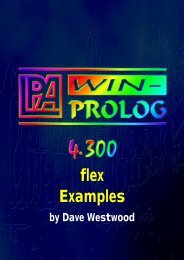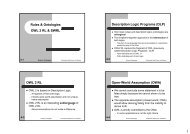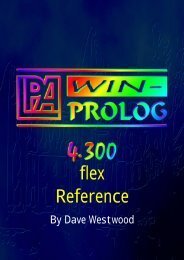A Review of Multi-Label Classification Methods - LPIS
A Review of Multi-Label Classification Methods - LPIS
A Review of Multi-Label Classification Methods - LPIS
You also want an ePaper? Increase the reach of your titles
YUMPU automatically turns print PDFs into web optimized ePapers that Google loves.
categorization (Li & Ogihara, 2003) and semantic scene classification (Boutell et al., 2004). Insemantic scene classification, a photograph can belong to more than one conceptual class, such assunsets and beaches at the same time. Similarly, in music categorization a song may belong to morethan one genre. For example, several hit songs <strong>of</strong> the popular rock band Scorpions can becharacterized as both rock and ballad.This paper aims to serve as a starting point and reference for researchers interested in multi-labelclassification. The main contributions are: a) a structured presentation <strong>of</strong> the sparse literature onmulti-label classification methods with comments on their relative strengths and weaknesses andwhen possible the abstraction <strong>of</strong> specific methods to more general and thus more useful schemata, b)the introduction <strong>of</strong> an undocumented multi-label method, c) the definition <strong>of</strong> a concept for thequantification <strong>of</strong> the multi-label nature <strong>of</strong> a data set, d) preliminary comparative experimental resultsabout the performance <strong>of</strong> certain multi-label methods.The rest <strong>of</strong> the paper is organized as follows. The next section discusses tasks that are related to multilabelclassification. Subsequently follows an organized presentation <strong>of</strong> multi-label classificationmethods. The next section introduces the concept <strong>of</strong> label density and presents the metrics that havebeen proposed in the past for the evaluation <strong>of</strong> multi-label classifiers. The following section presentsthe comparative experiments and discusses the results, while the concluding section summarizes thiswork and points to future research directions.RELATED TASKSA task that also belongs to the general family <strong>of</strong> supervised learning and is very relevant to multi-labelclassification is that <strong>of</strong> ranking. In ranking the task is to order a set <strong>of</strong> labels L, so that the topmostlabels are more related with the new instance. There exist a number <strong>of</strong> multi-label classificationmethods that learn a ranking function from multi-label data. However, a ranking <strong>of</strong> labels requirespost-processing in order to give a set <strong>of</strong> labels, which is the proper output <strong>of</strong> a multi-label classifier.








